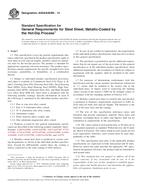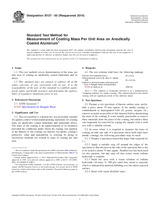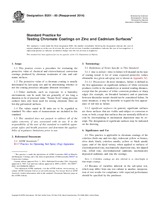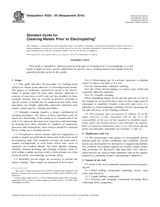Potřebujeme váš souhlas k využití jednotlivých dat, aby se vám mimo jiné mohly ukazovat informace týkající se vašich zájmů. Souhlas udělíte kliknutím na tlačítko „OK“.
ASTM B766-86(2015)
Standard Specification for Electrodeposited Coatings of Cadmium
Automaticky přeložený název:
Standardní specifikace pro elektrolyticky Coatings kadmia
NORMA vydána dne 1.3.2015
Informace o normě:
Označení normy: ASTM B766-86(2015)
Poznámka: NEPLATNÁ
Datum vydání normy: 1.3.2015
Kód zboží: NS-585709
Počet stran: 9
Přibližná hmotnost: 27 g (0.06 liber)
Země: Americká technická norma
Kategorie: Technické normy ASTM
Kategorie - podobné normy:
Anotace textu normy ASTM B766-86(2015) :
Keywords:
?€‰cadmium, electrodeposited coatings, electrodeposited coatings, cadmium ,, ICS Number Code 25.220.40 (Metallic coatings)
Doplňující informace
| 1. Scope | ||||||||||||||||||||||||||||||||||||||||||||||||||||
|
1.1 This specification covers the requirements for electrodeposited cadmium coatings on products of iron, steel, and other metals. Note 1: Cadmium is deposited as a coating principally on iron
and steel products. It can also be electrodeposited on aluminum,
brass, beryllium copper, copper, nickel, and powder metallurgy
parts.
1.2 The coating is provided in various thicknesses up to and including 25 μm either as electrodeposited or with supplementary finishes. 1.3 Cadmium coatings are used for corrosion resistance and for corrosion prevention of the basis metal part. The as-deposited coating (Type I) is useful for the lowest cost protection in a mild or noncorrosive environment where early formation of white corrosion products is not detrimental or harmful to the function of a component. The prime purpose of the supplementary chromate finishes (Types II and III) on the electroplated cadmium is to increase corrosion resistance. Chromating will retard or prevent the formation of white corrosion products on surfaces exposed to various environmental conditions as well as delay the appearance of corrosion from the basis metal. 1.4 Cadmium plating is used to minimize bi-metallic corrosion between high-strength steel fasteners and aluminum in the aerospace industry. Undercutting of threads on fastener parts is not necessary as the cadmium coating has a low coefficient of friction that reduces the tightening torque required and allows repetitive dismantling. 1.5 Cadmium-coated parts can easily be soldered without the use of corrosive fluxes. Cadmium-coated steel parts have a lower electrical contact resistance than zinc-coated steel. The lubricity of cadmium plating is used on springs for doors and latches and for weaving machinery operating in high humidity. Corrosion products formed on cadmium are tightly adherent. Unlike zinc, cadmium does not build up voluminous corrosion products on the surface. This allows for proper functioning during corrosive exposure of moving parts, threaded assemblies, valves, and delicate mechanisms without jamming with debris. |
||||||||||||||||||||||||||||||||||||||||||||||||||||
| 2. Referenced Documents | ||||||||||||||||||||||||||||||||||||||||||||||||||||
|
Podobné normy:
Historická
1.5.2008
Historická
1.10.2014
Historická
1.11.2014
Historická
1.3.2015
Historická
1.11.2014
Historická
1.11.2014
Odebírejte informace o nově vydaných normách ZDARMA:
Chcete pravidelně odebírat informace o nově vycházejících normách z celého světa a to zcela zdarma?
Přihlašte se k odběru. Vše je velice jednoduché a absolutně ZDARMA.
Na výběr máte vydavatele z celého světa.



 ASTM A917-08
ASTM A917-08 ASTM A924/A924M-14..
ASTM A924/A924M-14.. ASTM B137-95(2014)..
ASTM B137-95(2014).. ASTM B200-85(2015)..
ASTM B200-85(2015).. ASTM B201-80(2014)..
ASTM B201-80(2014).. ASTM B322-99(2014)..
ASTM B322-99(2014)..
 Cookies
Cookies
